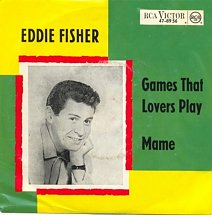| "Games That Lovers Play" | ||||
|---|---|---|---|---|
 | ||||
| Single by Eddie Fisher | ||||
| from the album Games That Lovers Play | ||||
| B-side | "Mame" | |||
| Released | October 1966 | |||
| Recorded | 1966 | |||
| Genre | Vocal pop, easy listening | |||
| Label | RCA | |||
| Songwriter(s) | Eddie Snyder, James Last, Larry Kusik, Rudolf Gunter-Loose | |||
| Producer(s) | Al Schmitt | |||
| Eddie Fisher singles chronology | ||||
| ||||
| "Games That Lovers Play" | ||||
|---|---|---|---|---|
 | ||||
| Single by Wayne Newton | ||||
| B-side | "Half a World Away" | |||
| Released | October 1966 | |||
| Recorded | 1966 | |||
| Genre | Easy listening | |||
| Label | MGM | |||
| Songwriter(s) | Eddie Snyder, James Last, Larry Kusik, Rudolf Gunter-Loose | |||
| Wayne Newton singles chronology | ||||
| ||||
| "Games That Lovers Play" | |
|---|---|
 | |
| Single by Connie Francis | |
| B-side | "Spanish Nights and You" |
| Released | October 1966 |
| Recorded | 1966 |
| Genre | Easy listening |
| Label | MGM |
| Songwriter(s) | Eddie Snyder, James Last, Larry Kusik, Rudolf Gunter-Loose |
"Games That Lovers Play" is a popular song composed by James Last which became a hit for multiple artists in 1966 and 1967. The song has been recorded more than 100 times. [1] Last's own version was included on his 1967 album Games That Lovers Play.